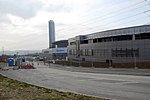Drakelands Mine

Drakelands Mine, also known as Hemerdon Mine or Hemerdon Ball Mine, is a tungsten and tin mine. It is located 11 km (7 miles) northeast of Plymouth, near Plympton, in Devon, England. It lies to the north of the villages of Sparkwell and Hemerdon, and adjacent to the large china clay pits near Lee Moor. The mine had been out of operation since 1944, except for the brief operation of a trial mine in the 1980s. Work started to re-open it in 2014, but it ceased activities in 2018. It hosts the fourth largest tin-tungsten deposit in the world.A new company, Tungsten West plc, now plan to re-open the mine in 2022, after investing to alter the processing plant. A ground up review lead to the recognition that the ore is not in fact Wolframite, but is in fact a related ore, Ferberite, and changes were needed to improve extraction efficiencies. In addition, a subsidiary will enhance the mine with aggregate sales as a by-product of mining.
Excerpt from the Wikipedia article Drakelands Mine (License: CC BY-SA 3.0, Authors, Images).Drakelands Mine
Ledgate Lane, South Hams
Geographical coordinates (GPS) Address Nearby Places Show on map
Geographical coordinates (GPS)
| Latitude | Longitude |
|---|---|
| N 50.41 ° | E -4.01 ° |
Address
Ledgate Lane
PL7 5FB South Hams
England, United Kingdom
Open on Google Maps







